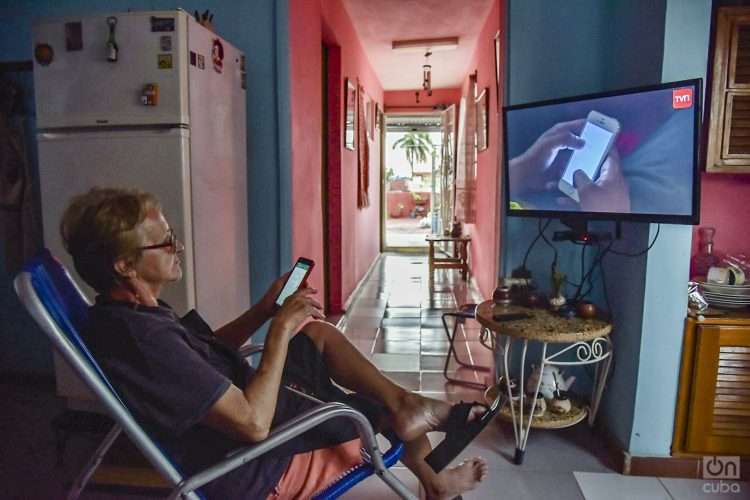The transition process to terrestrial digital television (DTV) in Cuba began almost a decade ago. According to the original timeline, the analog blackout should have already occurred. But, the most recent information given by Minister of Communications (MINCOM) Mayra Arevich, stated that the partial transition through the western provinces of Cuba would begin in September 2022. The same was said a year ago.
The entire process of deploying DTV on the island began in the now distant June 2013. The first steps included the delivery of decoder boxes donated by the Chinese government to 45,000 homes in Havana. With these devices, the first signal transmission and reception tests were carried out in the capital.
Conceived as a gradual process, it should have advanced towards the rest of the territories in a process of gradual analog blackout and conclude with 100% access of Cubans to the new television modality. The first date set for the completion of the move to the digital signal was the year 2021.
The project for the implementation of DTV was initially conceived in three stages. In a first of simultaneity and transition, the two types of transmissions would be maintained. This would last for about five years.
A second stage, scheduled to start in 2016, would include the installation of the first definitive transmission service and the start of the “analog blackout.” In the last period, the service would be fully extended, and high definition would be reached. The conclusion of the transfer in Cuba was foreseen for 2021.
On the other hand, in the previous year, when the “analog blackout” process was to be completed, Ana Julia Marine López, deputy minister of MINCOM, acknowledged that although the program had been conceived to last 10 years, it had been necessary to redesign it, in such a way that “the program extends until 2024,” according to her words.
However, the new date may not be the definitive one because, in theory, the current schedule set the start of the partial transition for 2021 “with the western provinces (November 30 and December 15); then, in 2022, from Villa Clara to Camagüey, and in the last phase, for 2023, the transition in the east of the country,” according to Marine López.
In practice, the transition in the west —which is the first to be undertaken— is already a year behind schedule compared to the new schedule.
How much progress has been made in nine years?
According to the most recent figures given by Minister Mayra Arevich, the population coverage on the island in terms of digital television in standard signal (SS) is 76.23%, and in high definition (HD), 45.7%.
Digital TV in the country has 143 installed transmission plants and space for broadcasting 12 channels. Of these, 8 channels are broadcast in SS and 4 in HD. The most basic logic shows that 76.23% of Cubans have access to 8 channels and only 45.7% have access to a total of 12. Meanwhile, 23.77% of the Cuban population does not have a digital signal, which is equivalent to more than 2 million residents in the country.
And, according to official numbers, very little progress has been made in the last two years in terms of increasing access by Cuban clients to the digital signal, since, as reported the previous year by the then Minister of Communications Jorge Luis Perdomo Dilella, at the end of 2020 the coverage was, in the case of standard definition (SD), up to 76% and, in the case of high definition (HD), up to 45%.
In terms of infrastructure, on the one hand, on the island there are still 138 identified zones of silence — where radio and television signals do not reach or are received with very low quality — distributed in seven provinces. On the other hand, among users who live in areas with access to the signal, the main obstacle lies in how to buy receiving equipment.
The number of receivers (hybrid TV sets and/or decoder boxes) that have been marketed since 2013, according to the current minister of communications, exceeds three million —although the exact figure was not specified— with an annual average of more than 100,000.
However, the minister acknowledged that this year the sale has been lower, with only about 61,151. This, despite the fact that the plans for the end of 2021 presented by Lázaro Campos, director of the Electrical Appliances Production Basic Business Unit, contemplated the completion of 318,000 decoder boxes and 32,000 32-inch hybrid TV sets.
In any case, the number of receiving equipment that has been marketed in almost a decade in Cuba is even lower than the number of households counted in the country in 2012, when the last census was carried out. At that time, 3,931,643 places were registered where families made up of one or more people reside.
Therefore, there are nearly one million more homes on the island than the amount of equipment sold between 2013 and 2022.
According to the most recent plans, this year it is expected that “the population coverage will reach 89% in standard definition and 60% in high definition,” said Mayra Arevich. A goal that contradicts the low sales rates of essential equipment.
Similarly, it has been reported that the intended plan is to conclude the process of partial transition from analog to digital television in the west of the country. Meanwhile, we are currently still going through the transition phase — the first planned — which was to last for 5 years starting in 2013, according to the original timeline.
DTV in Cuba: within everyone’s reach?
Access to DTV requires, like analog television, to have an outdoor or indoor antenna and a suitable downpipe. Of course, a digital TV set is required that receives the DTMB standard —Chinese standard for Digital Terrestrial Multimedia Broadcast used in Cuba—, a hybrid TV set (analog and DTMB), or a DTMB decoder box (with an analog TV).
And this is where the process gets stuck. The sale of what are popularly known as “little boxes,” hybrid TV sets and other devices required to obtain the digital signal —antennas, coaxial cable— began in the country after the initial tests of digital broadcast in Havana in 2013.
At that time, the products were sold in the network of stores collecting foreign exchange and in freely convertible currency (CUC). The GELECT brand boxes, only produced for domestic use, were priced at 49.95 CUC and the 32-inch hybrid TV sets at 399.95 CUC. Imported receivers and TV sets were sold at higher prices. The supply was not entirely stable, nor were the prices really affordable.
But everything got worse when, as a result of the crisis that began to worsen in Cuba at the end of 2018, these devices also began to disappear from stores until they almost disappeared in 2020.
Among the main causes of the low commercialization —and production— of receptors in the country, the authorities underline the financial difficulties and the limitations in purchasing power and liquidity.
Most of the components and parts used in the equipment assembly process come from China, the main provider of technical assistance, affirmed Lázaro Campos, director of the Electrical Appliances Production Basic Business Unit.
As part of the partial dollarization that began in Cuba in 2019, what was established was the sale of this equipment in the network of stores in Cuban pesos and in freely convertible currency. In foreign currency, only high-end 43-inch hybrid LED TVs and decoder boxes with android operating system would be marketed, according to statements by Albeo Zamora Quintero, vice president of the Group of the Electrical Industry, Information Technology, Automation and Communications (GELECT).
In addition, it was affirmed that equipment would be available as of 2021. José Luis Perdomo Dilella confirmed that from the second quarter of that year they should be in stores, especially in those places where the partial transition from analog to digital television was first made. In fact, the value of 1,250.00 Cuban pesos was established for the sale of the boxes.
What has really happened? The sale to the population of decoder boxes in national currency began in some western municipalities and at a price set by the State, and this was confirmed online by several users.
But the sale was not regulated and the equipment ended up in the hands of resellers. Neither was marketing guaranteed in at least one store in each municipality of the western region of the island, as planned.
In the rest of the country, the sale of this equipment in national currency is still a remote reality.
Decoder boxes and hybrid LED TV sets are sold in foreign currency with offers for online purchase from abroad and in the network of stores that sell in freely convertible currency, at a cost of $50.00 for boxes and $535.00 for imported 43-inch TV sets. On the black market, the value of the former currently exceeds 10,500 Cuban pesos.
In short, the deployment of DTV in Cuba, with its indisputable benefits in terms of the quality of the received signal, with distortion-free images and clearer sound, depends on the availability of the required means and for Cubans to be able to afford them. As long as this does not happen, the schedules will remain unfinished and the signal will remain in the air, without us being able to make it ours.










